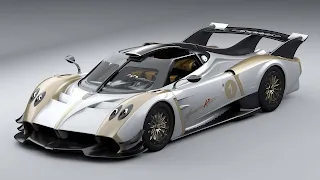pagani
1.Early Beginnings (1950s-1970s)
-
Founder: Horacio Pagani, born in Argentina in 1955, was passionate about cars from a young age. He moved to Italy in the 1970s to work in the automotive industry.
-
Career at Lamborghini: Horacio Pagani's big break came when he joined Lamborghini in the late 1970s. He worked as a chief engineer and helped design some important Lamborghini models, including the Lamborghini Countach, a car that would become one of the most iconic supercars of all time.
-
Fonderie Automobili: Pagani left Lamborghini in the early 1980s and founded his own company, Fonderie Automobili, in Modena, Italy, where he would eventually start working on his own dream car.
2. The Birth of Pagani Automobili (1992)
-
Pagani Automobili was officially founded in 1992 in Modena, Italy, with the vision of creating a hypercar that combined advanced technology with artistic design and craftsmanship.
-
Zonda: The first production car, Pagani Zonda, was introduced in 1999. The Zonda quickly became famous for its unique, aggressive styling, lightweight construction, and extreme performance.
-
The Zonda's design and engineering were groundbreaking, incorporating materials such as carbon fiber and titanium, which were not commonly used in supercars at the time.
-
The Zonda featured a V12 engine from Mercedes-Benz and an advanced aerodynamic design, earning praise for its handling, speed, and overall driving experience.
-
3. The Zonda Era (1999-2019)
-
Zonda C12: The first Zonda model, the C12, debuted in 1999, showcasing Pagani's vision of a high-performance supercar. The car's lightweight carbon fiber structure, aerodynamic features, and Mercedes-Benz-powered V12 engine made it a standout in the automotive world.
-
Zonda Roadster: In the early 2000s, Pagani released a roadster version of the Zonda, enhancing the car's appeal with a convertible variant.
-
Zonda F (2005): A refined version of the Zonda, the Zonda F, was released with improved performance, better handling, and updated design elements. The car became even more exclusive and sought after.
-
Zonda R (2009): Pagani introduced the Zonda R, a track-focused version of the Zonda with a 6.0L V12 engine that produced over 750 horsepower. The Zonda R was not street legal, further emphasizing its role as a track-focused hypercar.
-
The Zonda continued to evolve over the years with limited-edition models and unique variants, including the Zonda Cinque, Zonda Tricolore, Zonda 760, and Zonda HP Barchetta, among others. Pagani produced only a handful of these bespoke models, each tailored to the preferences of the lucky owners.
4. The Huayra Era (2011-present)
-
Pagani Huayra: In 2011, Pagani unveiled its successor to the Zonda: the Huayra. The Huayra was a complete departure from the Zonda's design and philosophy, introducing a more refined, yet still aggressive, look.
-
The Huayra was powered by a Mercedes-Benz-sourced 6.0L twin-turbo V12 engine and introduced advanced technologies such as active aerodynamics (adjustable flaps) and a cutting-edge interior.
-
It was a huge leap in terms of both performance and luxury, with the car being described as a masterpiece of automotive design and engineering.
-
The Huayra Roadster and Huayra Roadster BC followed, further expanding the Huayra family with even more power and improved handling.
-
-
Huayra BC (2016): The Huayra BC was introduced in 2016, a more extreme version of the Huayra, with a significant weight reduction and increased power. The car was named after Beniamino Cavallino, a close friend of Pagani and a key supporter of the brand, who tragically passed away in a car accident.
-
Huayra R (2021): In 2021, Pagani introduced the Huayra R, a track-only version of the Huayra. It featured a naturally aspirated V12 engine capable of producing over 850 horsepower, offering an even more intense driving experience than the standard Huayra.
5. The Pagani Brand Today (2020s-present)
-
Pagani’s Focus on Exclusivity: As of today, Pagani continues to focus on extremely limited, highly customized vehicles. The brand’s cars are sold in small numbers (often less than 100 units per model), emphasizing craftsmanship, art, and exclusivity.
-
Pagani’s cars have always been more than just performance machines; they are pieces of art, with each model being highly customizable in terms of both design and materials. The brand uses exotic materials like carbon fiber, titanium, and aluminum, and often incorporates hand-finished details like leather upholstery, unique paint jobs, and bespoke interior designs.
-
The company remains an independent brand, with Pagani continuing to push the limits of automotive engineering with each new release.
6. Pagani and the Future
-
Electric Transition: While Pagani has remained true to its focus on traditional internal combustion engines, the future of the hypercar world seems to be leaning toward hybrid or electric powertrains. There have been rumors and speculation regarding the brand’s plans to explore electrification, though Pagani has not yet revealed any concrete details.
-
Future Models: Pagani has hinted at future models, possibly a successor to the Huayra or a new design direction entirely, but they have yet to unveil anything beyond limited-edition versions of the Huayra and the Huayra Roadster.
Legacy
-
Pagani has created some of the most extraordinary supercars ever made, with a focus on performance, craftsmanship, and exclusivity. The cars are not only technological masterpieces but also works of art, combining advanced engineering with aesthetic beauty.
-
Pagani’s legacy is defined by the meticulous attention to detail, the use of exotic materials, and the ability to create vehicles that are not just fast, but visually captivating. Their cars have gained legendary status among automotive enthusiasts, with each one being highly sought after by collectors.


Comments
Post a Comment